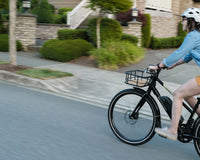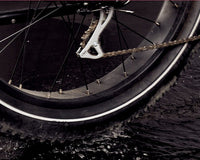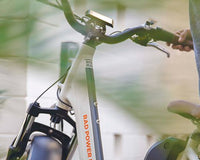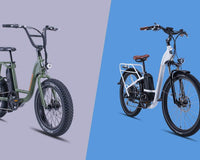There’s a little saying that, as Canadians, most of us know: “You’re only cold if you don’t dress for the cold.” In most weather (alright, Winnipeg, don’t come for us), if you dress properly, you are less likely to experience freezing wind-chill and frosty discomfort. While the negative Celsius temps challenge outerwear to its absolute performance levels, it is still possible to hop on and ride in the winter.
We break down what’s involved in winter apparel, and how to best outfit yourself for winter ebiking.
1. Cover As Much Skin As Possible
If your skin is exposed, it’s vulnerable to not just the cold temperatures, but the wind, which can get downright nippy. There are three places that tend to get overlooked: ankles, hands, and head.
Are your socks long enough to meet your pant leg (or pant leg long enough to reach your ankle)? Do you have gloves that tuck in or seal over your coat? And finally, is your face covered as much as possible?
Follow your grandma’s advice at the beach and cover up. Warm up your neck and lower face with the use of a neck gaiter. Don’t forget your ears - if you own a winter helmet, such as one used for skiing or snowboarding, simply use it for winter ebiking, too. Don’t wish to own a separate helmet? Invest in a balaclava, covering your neck, face, scalp, and ears.
Finally, your eyes can water and struggle with the effect of sunshine on snowpack. Sunglasses and better yet, snow goggles, help abate the wind and provide clarity.

2. Know Your Layers: Base, Mid, and Outer
Layers are just that - clothing meant to pile on top of the other, each adding an additional level of warmth. Determining the right combination depends on multiple factors: your exercise output, natural body heat, external temperatures, weather. We review each layer separately.
3. All About That Base
A base layer is designed to fit snug to your body. It should be warm, close-fitting, comfortable, and ideally wick away sweat.
Examples of a base layer:
- Longsleeve quarter-zip or crew-neck top: Wool or synthetic
- Tight-like pants: Wool, fleece, or synthetic
Before donning a base layer, ask yourself:
- Do I need to wear the base layer as an outfit at my destination?
- What material and fabrics are in my outerwear?
Riding for exercise? Try a snug legging and top in wicking material, such as merino wool (fleece can sometimes be too warm, however, many “winter” legging options are limited to fleece material). Individuals allergic to wool can also use synthetic fabrics that emulate the same sweat-wicking, yet warmth-inducing properties.
If you wish to wear base layers that pass for an everyday outfit, and don’t estimate sweating on your ride (this is ebiking after all! Put that motor to use!); seek out thicker athletic leggings or tech pants that are fleece lined. Swap out the close-fitting top for a pullover that is warm, comfortable, and destination-appropriate.
Finally, consider your outer layer when dressing for your under layer - if it’s heavily lined or without ventilation, dressing with additional warm layers might cause you to overheat.

4. Happy Medium
A medium layer is a somewhat thin, looser piece of clothing that is sandwiched between your base and outer layers. It is intentionally lightweight and what retailers often call “packable” - easily scrunched up and packed away in a backpack or bike basket.
Examples of a midlayer:
- Quarter-zip pullover: Fleece or synthetic
- Vest: Quilted or fleece
- Lightweight jacket: Quilted or fleece
Before donning a midlayer, ask yourself:
- Will I have an outer layer that already includes a lining?
- Does the temperature require extra warmth?
If your outer layer is a waterproof shell, chances are, it does not include fabric lining. This is done intentionally, to allow the wearer more flexibility. One can pop on as many layers as they need underneath the shell. However, if your outer layer includes a lining, a midlayer may be too warm and cause you to overheat.
The best solution is to choose a midlayer that can easily be added or removed. Bring it along as your trusty “just-in-case” item, and use it to add or take away insulation.

5. Think Outside the Layers
An outer layer’s sole responsibility is to repel the elements - wind, rain, snow, and even hail. It should fit looser to accommodate base and midlayers. And, since you’re cycling, an ideal jacket is easily visible in traffic: lighter in color with reflective tape.
Examples of an outer layer:
- Shell: Waterproof or water-resistant fabric
- Lined coat: waterproof or water-resistant fabric
Before zipping up an outer layer, ask yourself:
- What temperatures should my jacket withstand?
- What time of day will I be riding?
- How comfortable will I be with multiple layers underneath?
All winter jackets are not created equal, and for good reason. Jackets are designed for multiple purposes and uses. Some are better for winter ebiking than others: Waterproof is preferred, but water-resistant is a good runner-up. Materials that are bigger, puffier, or looser may interfere with cycling movement.
A thinner material without an internal layer gives you additional flexibility when dressing for the outside temperature; you can adjust your base- and midlayers. Finally, ensure your sleeves and shoulders don’t “tug” and that you can easily move, cycle, and alert traffic with minimal restriction.

6. Yes, You Can Overheat
Sweat can freeze. Too much warmth and your body will generate sweat, then, following the body’s natural processes, cause you to chill. The instant you begin to feel too warm, peel off a layer, or use your clothing and accessories to “vent.”
7. Buy for Breathability
Your winter ebike commute in the morning may be much chillier than your trip home. Avoid overheating by purchasing items that allow you to adjust your temperature with additional air flow.
- Buy a helmet with vents that open and close
- Seek out an outer layer that offers multiple “vented” areas, such as armpit zips and side zips (running vertical alongside your torso)
- Consider purchasing quarter-zip base layers, offering the ability to circulate air in your core
- Shop for gloves that include a zippered outside pocket; stash a handwarmer inside on cooler days, and unzip for breathability on warmer days
- Purchase Rad’s Bar Mitts to protect your hands and easily handle your ebike
As a company whose flagship ebike is its RadRover 6 Plus fat tire, Rad Power Bikes delivers on additional fat tire ebikes, including the award-winning “best commuter bike” RadCity and the go-where-you-go foldable fat tire RadMini. Hop on and navigate the winter months, going places no matter the weather. (Almost all weather - ensure your battery works properly by avoiding rides in temperatures lower than -4 °F /-20 °C.)
You have the electric bike - now, you know what to wear on the road. Stay warm out there!








